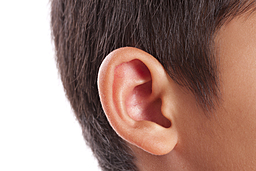Ear Implant for Reconstruction
TECHNOLOGY NUMBER: 7095

OVERVIEW
A specialized two-component scaffold design to correct ear malformations- Scaffold design supports tissue ingrowth and a soft tissue covering and requires no cartilage.
- The 3D printed implant can be personalized to match the shape of a patient's healthy ear
BACKGROUND
Malformed ears due to microtia, congenitally unformed auricle, or traumatic injuries are difficult to reconstruct due to their complex geometry. However, reconstruction early in life or following a trauma can prevent hearing difficulties and diminish psychosocial harm and low self-esteem associated with these types of malformations. Reconstruction may be carried out by harvesting a rib cartilage and shaping it to resemble the missing or malformed area. shaped to resemble the missing or malformed ear. This implant may be enhanced with skin grafts taken from other parts of the body. However, this approach is physically painful and often requires more than one surgery to complete. An alternative correction involves placement of a polymeric implant in a process known as augmentation or ear reshaping surgery. A surgeon creates a pocket in the soft tissues of the ear before placing an implant of the proper size and shape. Still, this implant is a one-size-fits-all solution, which may not work for children whose ears are still growing. As such, a new method for correcting ear malformations is needed.
INNOVATION
Researchers have developed a three dimensionally (3D) printed scaffold-based approach to correct for ear malformations. This approach utilizes a porous implant designed to support both tissue ingrowth and a soft tissue covering. This scaffold is designed to replicate the intricate anatomy of a normal ear, including the helix, antihelix, concha, and lobule. The resulting ear implant is capable of growing with the child. High-resolution imaging techniques, such as CT scans or MRI scans, may be used to capture detailed images of the patient's ear and surrounding structures. Since the reconstruction does not involve the use of patient cartilage, the procedure can be performed on young children. If the contralateral ear is intact, the new implant can be designed as a mirror image using the normal anatomy as a template. The process includes a fist step that defines an outer ear framework and a second that constructs the base. Using a 3D scaffolding approach offers several advantages, including enhanced precision, customization, and the ability to create a more anatomically accurate reconstruction compared to traditional methods.
PATENT APPLICATION
Number: WO 2018/200816